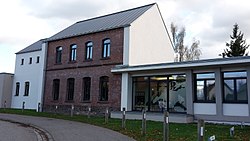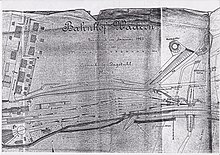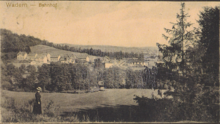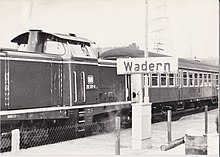Wadern train station
| Wadern train station | |
|---|---|
|
Former train station in Wadern
|
|
| Data | |
| Location in the network | Intermediate station |
| Platform tracks | 3 |
| opening | December 10, 1897 |
| location | |
| City / municipality | Waders |
| country | Saarland |
| Country | Germany |
| Coordinates | 49 ° 31 '39 " N , 6 ° 53' 33" E |
| Railway lines | |
|
|
| Railway stations in Saarland | |
The Wadern train station was outside the actual city center of Wadern . The construction of the station building took place in 1896 and ended in 1897. The station was considerably destroyed in the Second World War .
Due to the increase in individual and bus traffic , the station lost its importance and was finally closed in 1993. The former railway settlement is today's district of Dagstuhl .
location
The Wadern train station was in the Dagstuhl district. Since the Primstalbahn from Hermeskeil to Wadern was laid via Nonnweiler instead of the Löstertal , the station was built over a kilometer outside the city center of Wadern. Trains went via the station via the Primstalbahn to Lebach and via the Merzig-Büschfeld Railway to Büschfeld .
Buildings
The station consisted of a station building (Noswendlerstrasse 4), four residential buildings for civil servants with four apartments each (Bahnhofstrasse 2, 4, 5 and 7-9), an office building (Noswendlerstrasse 3), a goods shed , a station restaurant , and a reception hall and an overnight room (Bahnhofsstraße 6), which was converted into a primary school in 1921 . There was also a locomotive station subordinate to the Völklingen depot , which consisted of a three-tier locomotive shed , a coaling system and a loading line . From 1897 to 1929 the Wadern station was the seat of the railway maintenance office. A total of three tracks ran through the station.
history
Construction and opening
After the decision was made to build the Primstalbahn Wemmetsweiler – Nonnweiler, construction of the station building began in 1896 and was completed in 1897. At the same time, two service buildings and two residential buildings were built for the staff. On December 10, 1897 the Lebach – Wadern – Nonnweiler section was opened. The celebrations for this were held in Wadern. In addition to the economic advantages that Wadern received from the connection to the rail network, many miners and smelters were able to get home to the high forest , at least on weekends .
Further construction work was carried out between 1905 and 1921.
The station building and the goods shed were expanded and two residential buildings were added. In addition, the overnight room was converted into a primary school.
World War I and World War II
During the First World War , the station was used to transport troops to the Western Front .
From 1897 to 1925 there was a locomotive station with five locomotives, from 1897 the place was the seat of a railway maintenance office for 32 years. On June 2, 1923, the railroad settlement was occupied by French troops. Some of the families of the railway workers were expelled.
Between the two world wars, the development of the railroad experienced a rapid increase. In 1904, 20 passenger trains a day left Wadern as planned. In 1913 there were already 26. After the First World War, 22 trains left daily in 1919 and ten years later there were 39. In addition, there were the workers' trains to the coal mines and at least one freight train a day.
At the beginning of the Second World War in 1939, a loading ramp was built. During the war, trains with building materials to the Siegfried Line and evacuation trains from the Red Zone passed through Wadern . From September 1939 to June 1940 the station and the surrounding settlement served as a reception camp for railway personnel, for example from Saarbrücken and Völklingen , at times for up to three hundred people.
On May 27, 1944, the first air raid on a train entering the station from the direction of Büschfeld was recorded. The engine driver was killed. The second air raid on January 15, 1945 resulted in significantly more deaths. A bomb hit Bahnhofsstrasse. 8, nine people lost their lives. According to the Dagstuhl mayor, a total of 62 air raids on the station took place in 1944 and 1945. According to American archives, there were only 16. Although the station was enormously destroyed in World War II, from August 13, 1945, two trains per day were running again.
Decline
The last innovations at the station were made in 1957 with the construction of the station restaurant and the reception hall. As individual traffic increased, the residential building on Bahnhofsstr. 2 1961 for the construction of a new road. In the period that followed, the rails were only used by a few special trains .
The Wadern – Nonnweiler section was closed for passenger traffic on October 3, 1959, and for freight traffic on April 30, 1968.
However, hardly a train had run here since 1945. Passenger traffic between Wadern and Lebach and between Dillingen and Wadern ceased on May 30, 1980.
After that there was regular freight traffic to Wadern until May 30, 1992.
With the dismantling of the tracks between Wadern and Büschfeld, which began on December 1, 1993 , the city was finally decoupled from the rail network .
The railway settlement developed into an independent village, which in 1974 became part of the municipality of Wadern, and from 1978 city of Wadern .
Todays use
The former, under monument protection standing, railway houses can be still at the brick architecture recognized. The station building, which is also listed, has been completely refurbished and since 2012 it has housed a crèche and a family center for the St. Maria Weiskirchen child and youth welfare service.
literature
- Announcements from the Association for Local Lore Wadern - Issue 14 - Wadern 2008
- Chronology of the station (Association for History Wadern, http://www.heimatkunde-wadern.de )
Web links
- Advantic system house: Merzig-Wadern district - family. In: merzig-wadern.de. December 8, 2017. Retrieved December 8, 2017 .











